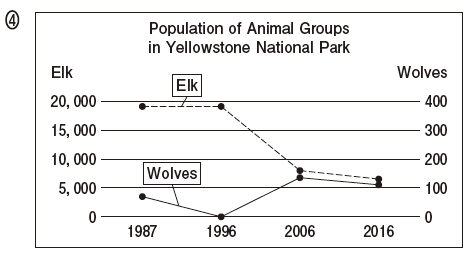You are studying about world ecological problems. You are going to read the following article to understand what has happened in Yellowstone National Park.
The wolves’ numbers had declined by the 1920s through hunting, which was not regulated by the government. Ranchers on large farms raising cattle, horses, and sheep did not like wolves because they killed their animals. When the wolves were on the point of being wiped out by hunting, another problem arose— the elk herds increased in number. Elk, a large species of deer, are the wolves’ principal source of food in the winter. The elk populations grew so large that they upset the balance of the local ecosystem by eating many plants. People may like to see elk, but scientists were worried about the damage caused by the overly large population.
To solve this problem, the U.S. government announced their intention to release young wolves brought from Canada. It was hoped that the wolves would hunt the elk and help bring down the population. However, because many ranchers were against bringing back wolves, it took about 20 years for the government and the ranchers to agree on a plan. In 1974, a team was appointed to oversee the reintroduction of wolves. The government published official recovery plans in 1982, 1985, and finally in 1987. After a long period of research, an official environmental impact statement was issued and 31 wolves were released into Yellowstone from 1995 to 1996.
This project to reduce the number of elk was a great success. By 2006, the estimated wolf population in Yellowstone National Park was more than 100. Furthermore, observers believe that the wolves have been responsible for a decline in the elk population from nearly 20,000 to less than 10,000 during the first 10 years following their introduction. As a result, a lot of plants have started to grow back. The hunting of wolves is even allowed again because of the risk from wolves to ranchers’ animals. While hunting wolves because they are perceived as a threat may seem like an obvious solution, it may cause new problems. As a study published in 2014 suggested, hunting wolves might increase the frequency of wolves killing ranchers’ animals. If the leader of a wolf pack is killed, the pack may break up. Smaller packs or individual wolves may then attack ranchers’ animals. Therefore, there is now a restriction on how many wolves can be hunted. Such measures are important for long-term management of wolf populations.
問1 The decline of wolves in Yellowstone National Park in the early 1900s resulted in ( ).
1. a decrease in the number of hunters, which was good for the wolves
2. a decrease in the number of ranchers, which reduced the human population
3. an increase in the number of elk, which damaged the local ecosystem
4. an increase in the number of trees and plants, which helped elk to hide
問2 Out of the following four graphs, which illustrates the situation the best?


問3 According to the article, which two of the following tell us about the current situation in the park? (Choose two options. The order does not matter.)
1. More travelers are visiting the park than thirty years ago.
2. One species was saved but another has become extinct instead.
3. People have started hunting wolves around this area again.
4. The park has both wolves and elk, as well as rich vegetation.
5. There is a new rule to reduce the elk population in the park.
問4 The best title for this article is ( ).
1. A Decrease in the Number of Ranchers’ Animals
2. Addressing Problems With Nature’s Balance
3. Nature Conservation Around the World
4. Releasing Elk in National Parks
【解説】問1 正解率 55.9%
「1900年代の初め、イエローストーン国立公園のオオカミが減少した結果、( ) が発生しました」
1. a decrease in the number of hunters, which was good for the wolves
「オオカミに対して良かったハンターの数の減少」
2. a decrease in the number of ranchers, which reduced the human population
「牧場主の数が減少し、人間の人口が減少した」
3. an increase in the number of elk, which damaged the local ecosystem
「地域の生態系を破壊したエルクの数の増加」
4. an increase in the number of trees and plants, which helped elk to hide
「エルクが隠れるのを助けた木や植物の数の増加」
後半は置いといて、前半だけで見ると、「ハンターが減った」「牧場主が減った」「エルクが増えた」「木や植物が増えた」になります。
オオカミが減ったことによって、どうなったのでしょうか?
本文の第一段落に、こうあります。
「エルクの群れが増えた」
さらにこうあります。
「エルクの個体数は非常に多くなり、多くの植物を食べることで地域の生態系のバランスを崩しました」
ということで、正解は「3」です。ちなみにエルクとは「ヘラジカ」のことだそうです。
【解説】問2 正解率 36.9%
問2 Out of the following four graphs, which illustrates the situation the best?


第三段落の最後にこうあります。
「1995年から1996年までに31匹のオオカミがイエローストーンに解放されました」
ということは、1996年の時点でオオカミはイエローストーンに存在しているわけです。「3」と「4」のグラフの wolves に注目してください。1996年の wolves の数は 0 になっています。そのあとに増えていますので、放された瞬間にオオカミが絶滅なんてことはありませんよね。
ということで、この時点でこの2つを消すことができます。
第四段落にこうあります。
「さらにオオカミの導入から最初に10年間で、エルクの個体数が約20,000から10,000未満に減少したのは、オオカミが原因だと観察者は信じています」
オオカミが導入されたのが、1996年でしたね。そこから10年間でエルクが約20,000から10,000未満に減少したのは、「2」ですね。したがって正解は「2」です。
「1996年の時点でオオカミはいる」「10年間で約20,000から10,000未満に減った」という二点から、選択肢を絞っていく問題でした。
【解説】問3 正解率 17.5%
「記事によると、次のうちどれが公園の現在の状況について教えてくれますか? (2つのオプションを選択してください。順序は関係ありません)」
1. More travelers are visiting the park than thirty years ago.
「30年前よりも多くの旅行者が公園を訪れています」
旅行者の話はありませんでしたね。この選択肢はダメです。
2. One species was saved but another has become extinct instead.
「ある種は救われたが、別の種は代わりに絶滅した」
オオカミの代わりにエルクが絶滅したということでしょうか? 違いますね。
この選択肢を選んだ人は、第一段落のこれに騙されたようです。
1940年代までに、オオカミはイエローストーン国立公園からほとんど姿を消しました。
しかし、これは「the current situation / 現在の状況」ではありませんよね。この current がなければ、家畜の代わりにオオカミが絶滅したと考えて、ありっちゃありなのかな?
でも almost disappeared は絶滅とは違いますよね。いやグラフを見ると1987年の時点では絶滅しているんでしょうか。そんなこんなで、この選択肢を選んだ人がいたのかもしれません。
3. People have started hunting wolves around this area again.
「人々はこの地域の周りで再び狼を狩り始めました」
第四段落にこうあります。
「オオカミから牧場主の動物への危険があるため、オオカミの狩猟も再び許可されています。」
したがって一つ目の正解は「3」です。
4. The park has both wolves and elk, as well as rich vegetation.
「公園には豊かな植物と同様に、オオカミとエルクの両方がいます」
第四段落にこうあります。
「その結果、多くの植物が育ち始めました。」
オオカミについては、第一段落にこうあります。
「2016年12月現在、公園には少なくとも108匹のオオカミと11パック (社会家族) がいた」
現在のエルクに関しては、本文でかかれていませんが、常識的に考えて「いる」でしょう。問2のグラフから考えてもいいかもしれませんね。
ということで「4」も正解です。この「4」の選択率が36.5%と低かったようです。
5. There is a new rule to reduce the elk population in the park.
「公園のエルクの個体数を減らすための新しいルールがあります」
そんな話はありませんでした。オオカミを狩猟する数に制限があるという話はありましたけれどね。この選択肢はダメです。
したがって正解は「3と4」です。
正解率が低いですが、分析によると「2」を選んだ人が多かったようです。正解が一つではない、というのがいやらしいですね。ただ、今回は正解の数が分かっているので、まだましでしたね。
【解説】問4 正解率 51.8%
問題問4 The best title for this article is ( ).
この記事のタイトルとして何が一番ふさわしいか、という問題です。
1. A Decrease in the Number of Ranchers’ Animals
「牧場主の動物の数の減少」
4. Releasing Elk in National Parks
「国立公園でエルクの解放」
この2つは違いますね。どちらかというとオオカミの話の方が多いですものね。
2. Addressing Problems With Nature’s Balance
「自然のバランスに関する問題の対処」
3. Nature Conservation Around the World
「世界の自然保護」
迷うのはこの2つでしょうか。「3」を選びたくなってしまいますが、今回の問題はイエローストーンというアメリカの国立公園での話です。「世界」なんて大きな話ではありませんでした。
ということで「2」が正解ですね。



コメントをどうぞ